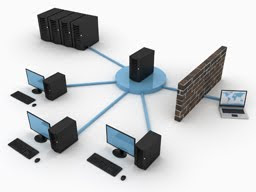
A network is a collection of computers and other devices connected to each other for the purpose of sharing information and resources. Common network elements include:
• Printers – one printer can be shared across several users
• File servers – a common repository of critical information, usually in the form of Word and Excel documents that can be shared across your company. Access can be controlled with security policies
• Application servers – Some programs do not run from the desktop, but rather, are accessed from a central server. SugarCRM is an example of a web-based application that can reside on an application server.
• Database servers – a common repository of business information, such as a client database, invoicing, purchasing, and reporting. Newer versions of QuickBooks allow for a database server configuration.
• E-mail servers – a server can be configured on your network to support e-mail access for your entire organization. Given the administrative overhead of providing > 99% uptime, spam reduction, and quotas for each user’s inbox, many smaller companies opt to use an external host for e-mail services. However, many larger companies do benefit from managing this internally.
• Shared Internet access – one Internet connection can be shared across your company without a noticeable reduction in performance for most basic applications
• Smart phones and other hand-held devices – Synchronization of calendars, contact information, and even Internet access and business applications can be accessed with many current hand-held devices
Properly configured and maintained, a network can help you streamline your business processes, increase productivity, and maximize the return on your investment in technology. A poorly implemented and/or a poorly maintained network can have exactly the opposite result.

No comments:
Post a Comment